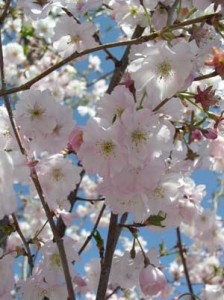Cherry Ornamental Trees- Pruning, Winter Care and Fertilizing

These trees should be pruned in early spring, before the sap starts to flow (March). This will remove some spring flowers, but promotes better growth. Pruning can also be done right after flowering. The time to make a long lasting effect on the form and structure of the plant is when the tree is young. Crossing or crowded branches, suckers and water sprouts should be removed. Low branches should also be removed, if desired, when the tree is young. This is best done by removing one or two branches a year, over a period of a few years, until the needed clearance is obtained. As the tree gets older, pruning every three to five years will keep the tree in good general shape. Water sprouts and suckers, however, should be removed each year. Newly planted trees respond very well to fertilization. Either granular, liquid or stake type fertilizers can be used. Granular fertilizers can be worked into the soil around the plant at a rate of 2 lbs or 2 pints per 100 square feet of planting bed. An alternative way to apply granular fertilizers starts with drilling or punching 6” deep holes at the drip line of the tree. Poured into these holes should be a total of 2 pounds of fertilizer per 1″ of trunk diameter (divided up and poured evenly between all of the holes). These holes should not be filled with more than 1/3 of the fertilizer and then they should be top filled with soil. This method of fertilization should only be done once a year, and is best done in late fall after leaf drop, or in early spring before the buds break. Multi Purpose 10-10-10 Fertilizer works well.
Liquid fertilizers (such as Miracle Gro) are mixed with water and applied the same as you would water the plant (see product for specific details). This should be done three or four times per year starting in late April and ending in mid July. Stake type fertilizers can be used following the directions on the package. With any of the above techniques, a higher nitrogen mix should be used; 20-20-20 or similar mix. Organic fertilizers, like manure, can also be used with good results. The material should be worked into open soil at a rate of one bushel per 1″ of trunk caliper or 100 square feet of bed area. As a tree matures, less fertilizing or lower nitrogen mixes should be used.
It is important to protect young trees from the winter sun. The trunks should be wrapped with a commercial grade tree wrap for the first two or three years. This wrap can be removed in the summer and then re-applied in fall.
Rabbits can do a great deal of damage to this plant in the winter. The plants can be protected with a fence formed with hardware cloth (looks like chicken wire but with small square holes). To do this, the plants branches should be tied in towards the center on smaller plants, and a circle of hardware cloth can be placed around the outside. Take care that the fence dose not rub and injure the bark. The base of the hardware cloth should be buried in the soil or mulch. This protection should be installed in late November and removed in mid April.
